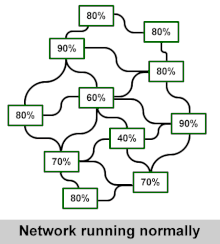( n - 1) rule
The ( n -1) rule (read: N-minus-one rule, also ( n -1) criterion ) designates an assessment criterion for the probability of failure on the basis of additional redundancy . If objects are responsible or available for a task , the operation or functionality of the other objects can be reliably guaranteed if the ( n -1) rule is observed if one object fails. The rule applies e.g. B. in the planning and operation of power grids or weir systems in rivers.
Applications
Electrical Power Engineering
In electrical power engineering , the ( n - 1) rule is used in the field of power grids, substations or power plants in order to maintain the overall operation of the power supply network in the event of failure or disconnection of equipment such as a power transformer , generator or overhead line . The ( n - 1) principle must be fulfilled for the maximum maximum load; if the load is lower, higher levels such as ( n - 2) can also be achieved. As part of operational management, the ( n - 1) rule serves as an essential criterion for bottleneck detection and is carried out by the transmission system operators in simulation calculations to estimate the consequences of topology changes in meshed power grids , for example before a specific switching operation in a substation.
In transmission networks , overhead lines for extra high voltage are in many cases designed as a so-called double system: On the overhead line pylon there are two three-phase systems with three conductor cables each, which are connected in parallel in the substations when the network is in a safe state. In this way, the transmission losses can be reduced in normal operation , each line is operated below 50% of the nominal power in this operation . If a three-phase system fails, for example due to an earth fault or as a result of a short interruption , the remaining conductor system can take over the entire load flow without the permissible limit values being exceeded. This avoids a brief power outage for the consumer.
When the ( n - 1) rule is applied, the evaluation is important: Double three-phase systems fail if, for example, as a result of extreme weather events in winter, such as in the Münsterland snow chaos in 2005 with high ice loads, many masts collapse and both three-phase systems of an overhead line fail at the same time . This case is particularly critical in power supply networks with a radial structure , since it is associated with direct and large-scale power failures. In so-called meshed networks, where the power flow can be transmitted via differently routed and adequately dimensioned lines, the ( n - 1) rule can also be met if a double line fails.
literature
- Theodor Strobl, Franz Zunic: Hydraulic engineering: Current principles - New developments . Springer, 2007, ISBN 978-3-540-47857-7 , pp. 140-143 .
- Adolf J. Schwab: electrical energy systems . 2nd Edition. Springer, 2008, ISBN 978-3-540-92226-1 , pp. 6-7 .
Individual evidence
- ↑ Alain Franck Kaptue Kamga: Cross- control area network congestion management with optimal topology measures . (PDF; 1.3 MB) Dissertation, University of Wuppertal, 2009, accessed on July 20, 2013 .



